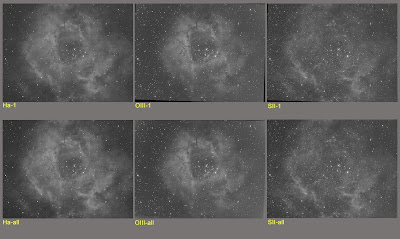The spiral arms show more detail than last years image and along with the details of the bright core and extraordinary dust and gas clouds makes for a pleasant image. NGC 2903 exhibits an exceptional rate of star formation activity near its center. The size of this galaxy is just a little smaller than our own Milky Way at about 80,000 light-years across making it a good twin of us (source: APOD). If you have a good eye just below the galaxy there is a small 'little fuzzy', this is PGC 27115 - UGC 5086, Stellarium has it listed as an active magnitude 18.00 galaxy.
NGC 2903
Location: Home Monroe, CT
Date: 3-5-19, 3-7-19, 3-25-19
Camera: ZWO ASI1600MM-Pro
Telescope: Astro-Tech AT115EDT 115mm Refractor Telescope
Barlow: None
Focal Length: 805mm
f/7
Focal Reducer: Astro-Tech 0.8x Focal Reducer/Field Flattener for Refractor Telescopes
Mount: Orion Sirius
Filter Wheel: ZWO EFW 8x 1.25"
Filter: ZWO R, G, B, L
Autoguiding: QHY-5L-II-M attached to an Agena 50mm Guide Scope with Helical Focuser
Exposure: R 40 x 90, G 39 x 90, B 38 x 90, L 57 x 90 (4.4 hrs)
Gain: 139
Offset 21
Temp: 0 C
Post Processing: PixInsight and Photoshop
https://kurtzeppetello.smugmug.com/
http://astroquest1.blogspot.com/
Date: 3-5-19, 3-7-19, 3-25-19
Camera: ZWO ASI1600MM-Pro
Telescope: Astro-Tech AT115EDT 115mm Refractor Telescope
Barlow: None
Focal Length: 805mm
f/7
Focal Reducer: Astro-Tech 0.8x Focal Reducer/Field Flattener for Refractor Telescopes
Mount: Orion Sirius
Filter Wheel: ZWO EFW 8x 1.25"
Filter: ZWO R, G, B, L
Autoguiding: QHY-5L-II-M attached to an Agena 50mm Guide Scope with Helical Focuser
Exposure: R 40 x 90, G 39 x 90, B 38 x 90, L 57 x 90 (4.4 hrs)
Gain: 139
Offset 21
Temp: 0 C
Post Processing: PixInsight and Photoshop
https://kurtzeppetello.smugmug.com/
http://astroquest1.blogspot.com/























